MyST Editor
This is a Markdown web editor that uses the MyST Markdown flavor. It is implemented as a Preact component. The intended way to use it is by embedding the editor in various websites/webapps. It is written with collaborative editing in mind.
Languages
MyST Editor
Copyright (c) 2022-2025 Antmicro
This is a Markdown web editor that uses the MyST Markdown flavor. It is implemented as a Preact component. The intended way to use it is by embedding the editor in various websites/webapps. It is written with collaborative editing in mind.
User Manual
For an overview of the editor usage, see the User Manual.
Demo
A demo of the editor is available here.
Main features
Live preview and dual pane sync
Changes in the text editor are immediately reflected in the preview. The editor also keeps track of where your cursor is and highlight and scroll the preview based on what you are editing.
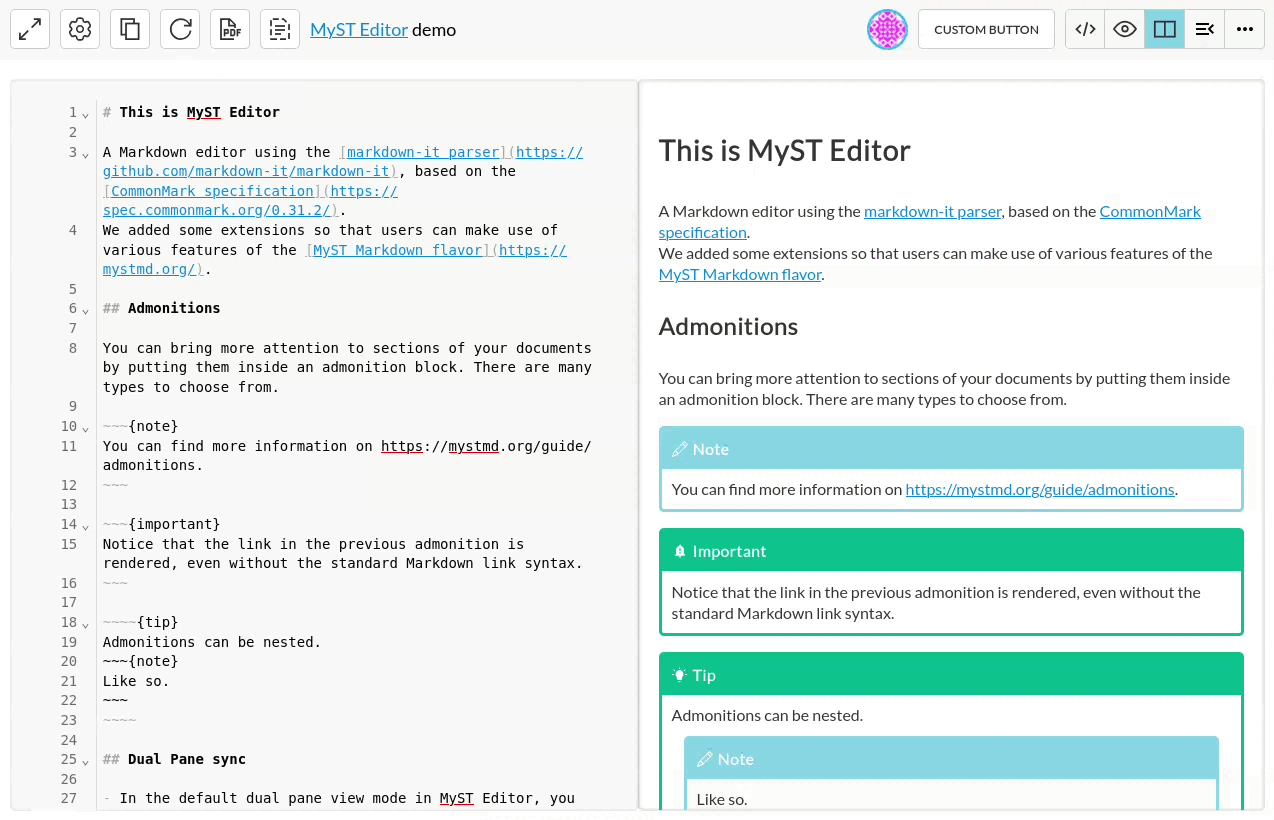
Inline Markdown rendering
You can toggle a mode where the Markdown will be rendered right in the editor.
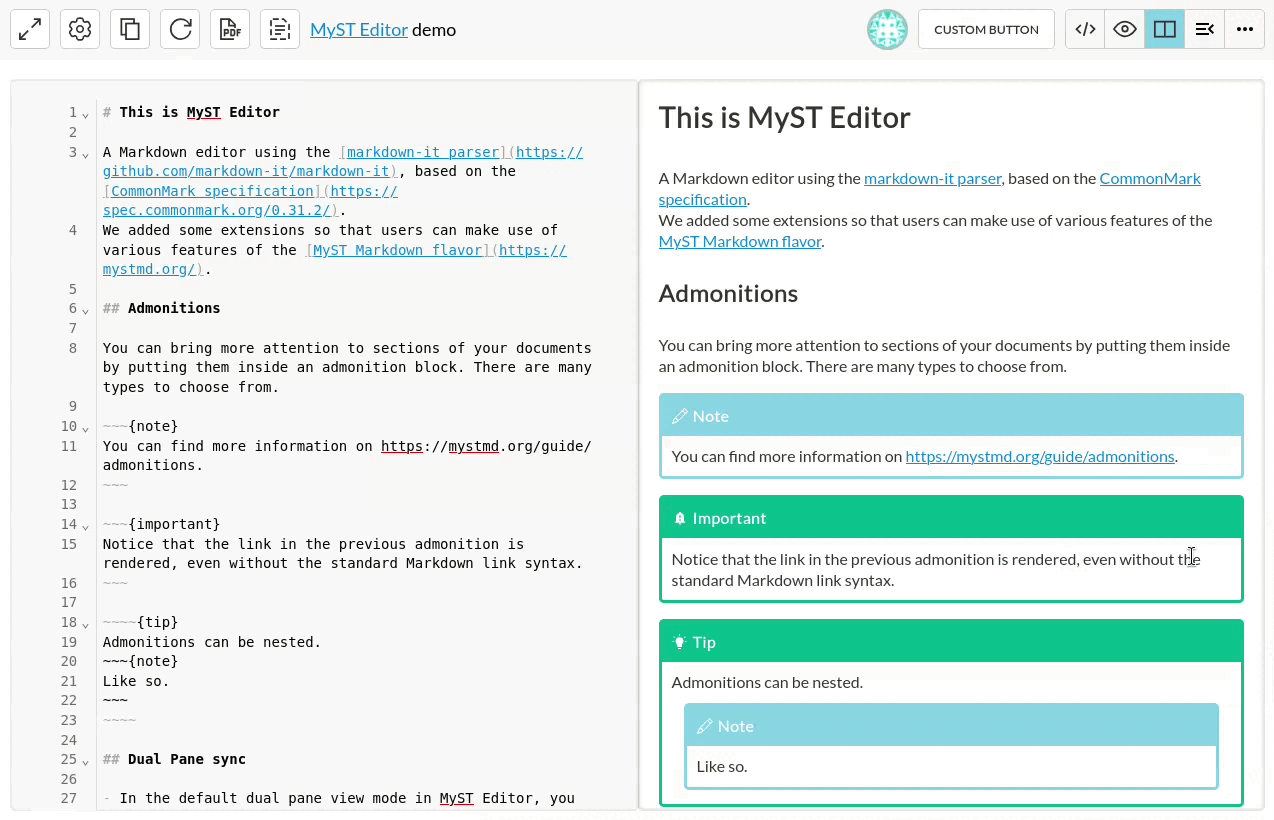
Collaborative editing
You can work on a document with multiple people at the same time.
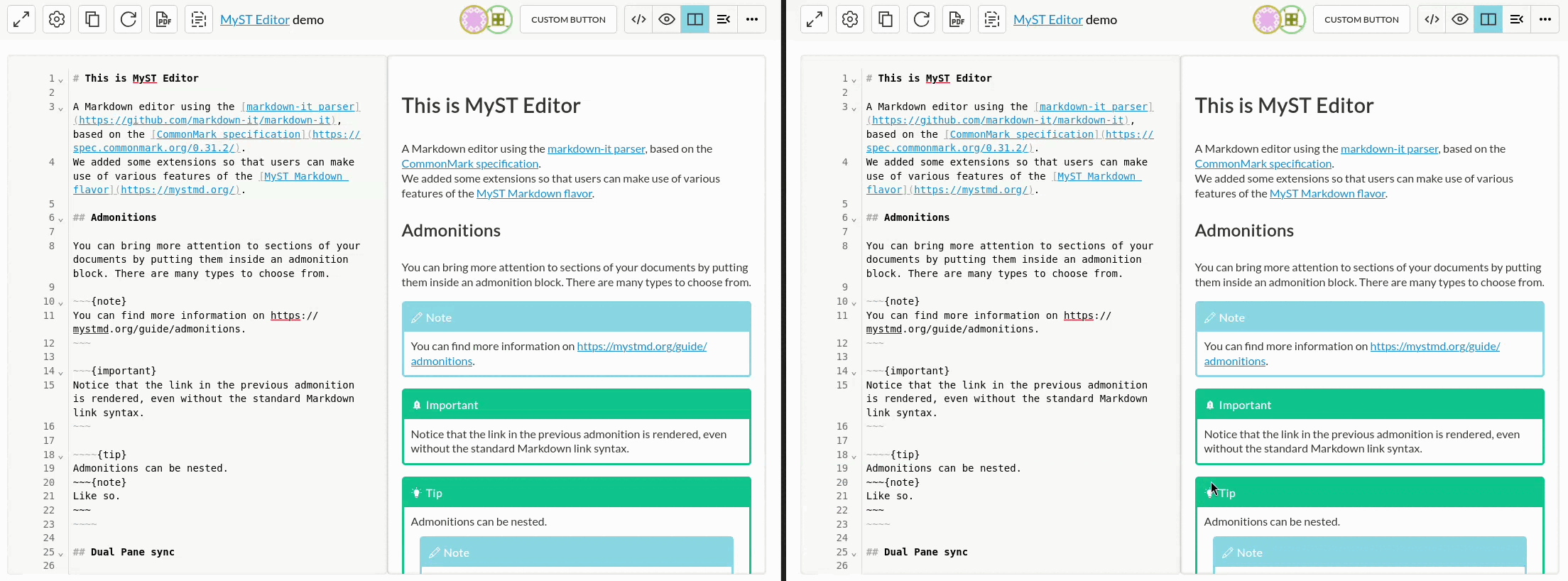
Comments
The editor has a comments feature, allowing you to add text that will not appear in the preview.

Suggestions
You can suggest changes that others can accept or reject later. Suggestions are based on the CriticMarkup syntax.
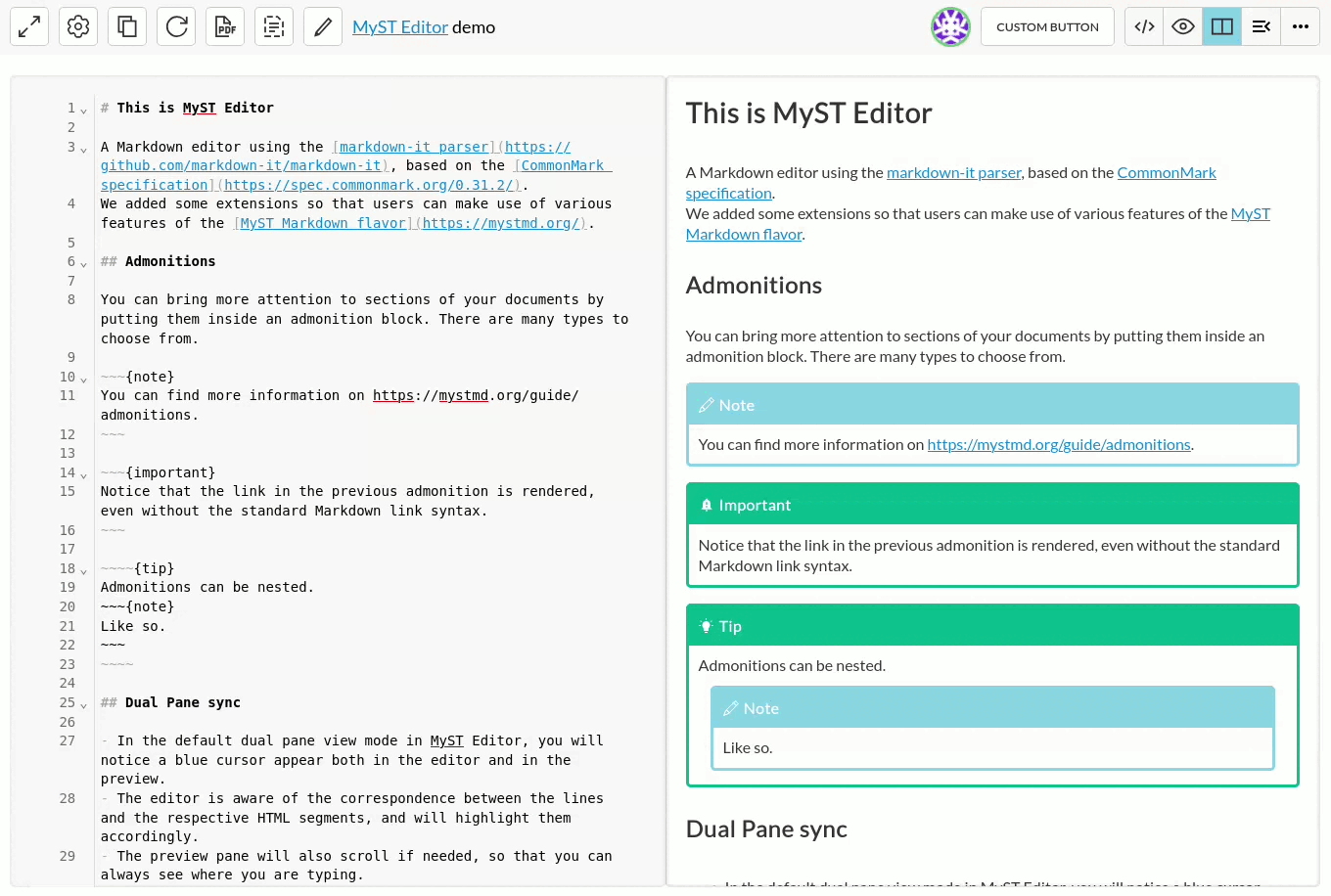
Templates
You can use document templates to quickly prepare documents and skip repetitive work.
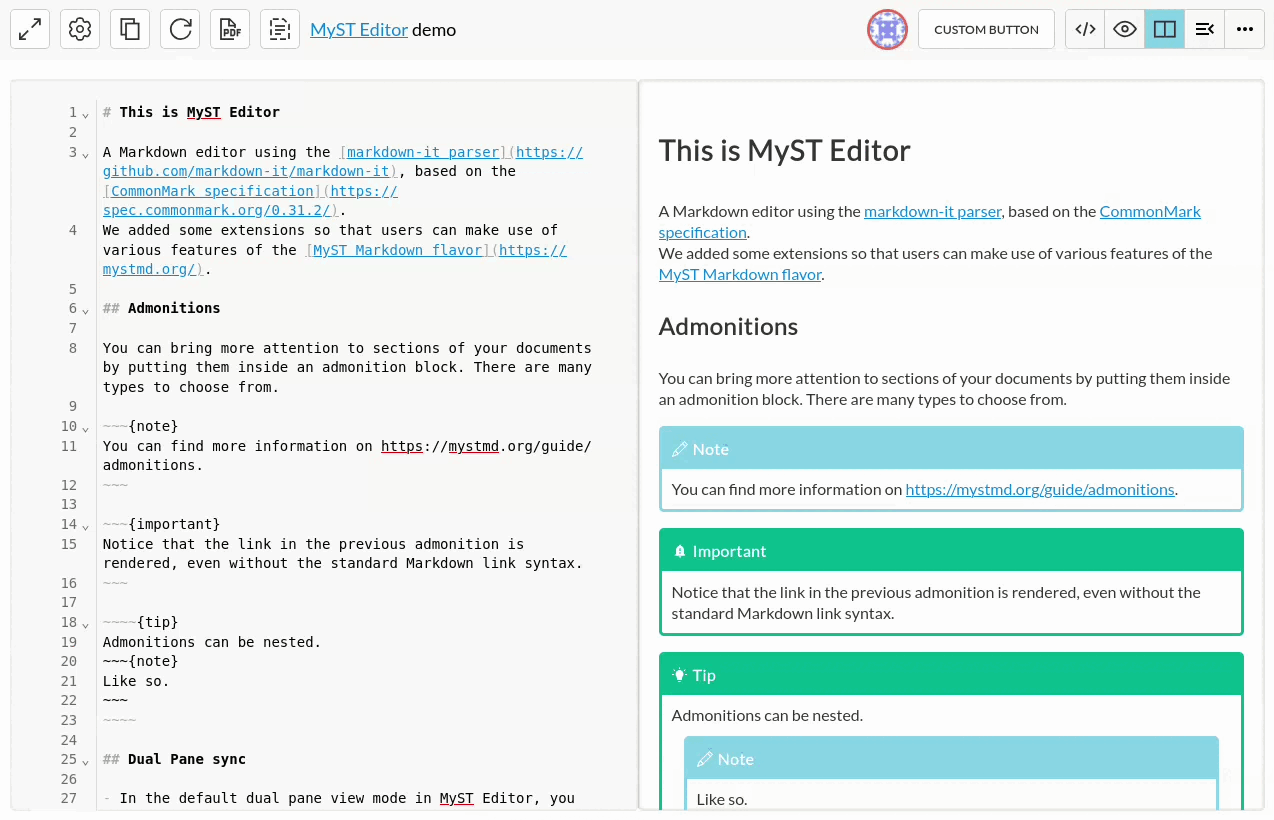
Diff
You can use the diff view to see exactly what changes have been made to the document as compared to the original state. There is also an option to discard all the changes.
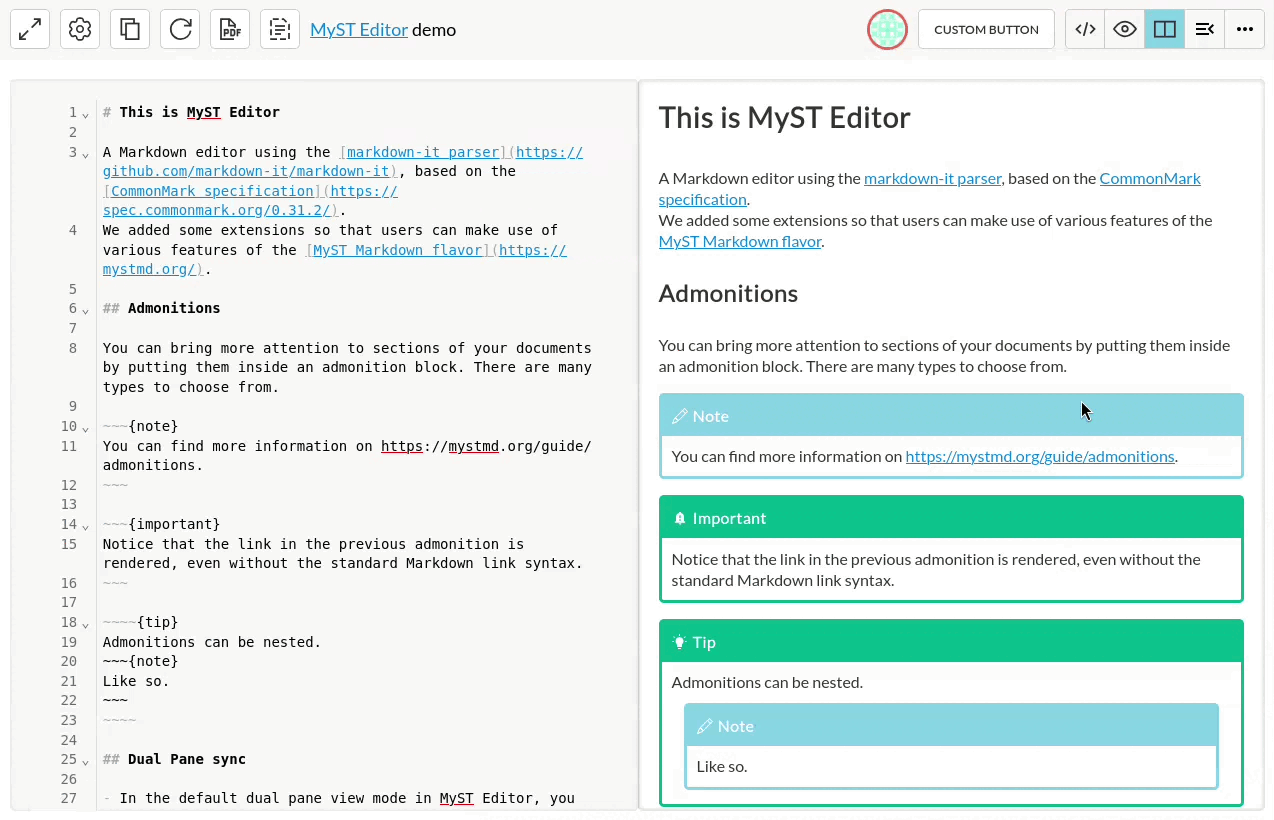
Exporting the document
Using the buttons in the top-left, you can copy the rendered HTML or export the document to a PDF file.

User settings
Users can customize the editor with the settings dropdown. In the example below, we can see settings that allow for scrolling past the last line of the editor and a Vim emulation mode.

Custom transforms
The editor allows you to extend the standard Markdown syntax with custom transforms. You can specify regular expressions that turn some input to custom HTML output. This is useful for implementing functionalities such as issue links, for example (as showcased in the demo):
const transforms = [{
target: /[0-9a-z\-]+\/[0-9a-z\-]+#\d{1,10}/g,
transform: (match) => {
const [repo, issueId] = match.split('#');
return `<a href="https://github.com/${repo}/issues/${issueId}">${match}</a>`
}
}]
Then provide the transforms array as the transforms option for the editor.
For more examples, see the exampleTransforms object in the demo HTML.
Usage
Building the component
npm i && npm run build
Using as a library
You can embed this editor on another website.
After building, you should see a dist folder with MystEditor.css and MystEditor.js in it.
Put those files alongside your HTML.
Add a link to the CSS file into your HTML:
<link rel="stylesheet" href="MystEditor.css">
You need an HTML element that MyST Editor will attach to:
<div id="myst"></div>
Add the following JavaScript as a module (of course add any options as needed):
import MystEditor from 'MystEditor.js';
MystEditor({ /* options */ }, document.getElementById("myst"));
And voilà!
Developing / running the demo
There is a demo available for the editor with some example Markdown and templates, also useful for development of the component itself.
To run it locally, use:
npm run dev
Your terminal will display what URL to open to see the demo.
You can edit the source files in src/ to modify the behavior of the component, with hot reload, thanks to Vite.
An analogous demo deployed with GH actions from latest main should be deployed at https://antmicro.github.io/myst-editor/
Collaboration server
The example server is located in the bin directory. To run it use:
cd bin
npm i && npm run server
You can change the port it runs on by setting a PORT environment variable.
Customizing the CSS
Note that MyST Editor uses the Shadow DOM to encapsulate the styles from the rest of the page.
In order to customize the look and feel, you can change the CSS variables
listed in MystStyles.js with the additionalStyles option
of the MystEditor function.
The editor exports an example darkTheme stylesheet.
MystEditor options
Here are the options you can pass to the MystEditor function:
id(default:crypto.randomUUID()) - this changes where the global state of an editor is stored, it is used when accessingwindow.myst_editorand is part of the CodeMirror parent DOM idname(default: "myst_editor_textarea") - this will change the name of the textarea element which contains your markdown. Useful if you want the editor to be part of an HTMLform.additionalStyles(CSSStylesheet|CSSStylesheet[]) - extra CSS stylesheets to customize the componenttitle- the document title displayed in the topbar. You can include Markdown links in here.mode(default: "Both", possibleValues: "Source" | "Preview" | "Both" | "Diff" | "Resolved" | "Outline" | "Inline") - changes what is visible when you open the editor. By default, you will see a split view with the text editor and preview.initialText(default: "") - initial Markdown textincludeButtons(default: defaultButtons) - An array of button definitions. A button definition is an object which has anaction: () => voidand eithericonortext. As an example, a button could be defined as{ text: "Button title", action: () => alert('clicked!') }topbar(default: true) - whether to show the topbartemplateList- path/url to a JSON file containing your document templates. For an example, seepublic/linkedtemplatelist.json.collaboration- options related to live collaboration:enabled(default: false)commentsEnabled(default: false) - enable basic comment functionality,resolvingCommentsEnabled(default: false) - enable resolving comments,wsUrl(example: ws://example:4444) - URL of the websocket serverusernameroom(default: "0") - name of the room to join, users will see others in the same roomcolor(default: "#ff0000") - color of the cursor seen by other usersmode(default: "websocket") - determines how the document will be synced. You can set it to"local"for testing without a server (using BroadcastChannel API)
spellcheckOpts- Configuration for the spellchecker. If the value is null or false then the spellchecker will be disabled.dict(default: "en_US") - Name of the desired dictionary. For an example, seepublic/dictionaries/en_US.dictionaryPath(default: "/dictionaries") - Path to a folder with dictionaries. For an example, seepublic/dictionaries/.
customRoles- custom MyST roles. See the demo HTML for examples.transforms- custom transformscustomDirectives- custom MyST directives. See the demo HTML for examples.getAvatar(default: (login) =>https://secure.gravatar.com/avatar/${login}?s=30&d=identicon) - a function that returns the avatar for a given usernamegetUserUrl(default: (login) =>#) - a function that returns the URL to the web page with the user's profile It is used when an avatar is clicked.backslashLineBreak(default: true) - treat\as a line break even when it is at the end of a paragraph/blockhideUsernameDelay(default: 5000) - milliseconds of inactivity after which the username attached to a remote cursor will be hiddensyncScroll(default: false) - synchronize scrolling of the editor and preview inDual Paneview mode.-
NOTE: This only works if you set a height limit on the editor parent element.
-
unfoldedHeadings(number?) - fold all but the given number of top level syntax nodes on startup. If the option is not set, nothing will be folded by default.mapUrl(default: (tag, url) => url) - function used to maphrefandsrcattributes. Tag is the name of the HTML element and url is the source url you can transform.yamlSchema- must be an absoulte URL. If provided, a language server will launch in the background to provide tooltips, diagnostics and autocompletions based on the schema in YAML code blocks.onPreviewClick((ev: MouseEvent) => boolean) - callback for when the preview is clicked, if the builtin click actions should be skipped, it should returntrueonDiscardChanges(() => void) - callback for when changes are discarded from the diff view modemermaidTheme(default: "neutral") - theme to use for Mermaid.js diagramscmDarkTheme(default: false) - whether to use a dark theme for CodeMirror
Also see the demo HTML for an example on how you can set these options.
Using window.myst_editor or the return value of the MystEditor function, you can modify these options at runtime.
Myst Editor for Git
There is an additonal wrapper around the base editor that is meant to be easy to integrate with Git version control. The wrapper is provided as a component located in src/myst-git/MystEditorGit.jsx. You can import it from a build of Myst Editor with the following syntax:
import { MystEditorGit } from "MystEditor.js";
There is an example page that makes use of this wrapper in src/myst-git/git.html.
The example page can be accessed while the Editor is running in development mode via the following URL: /myst-git/git.html.
License
Relevant projects
Nothing found
Apologies, but no results were found.
